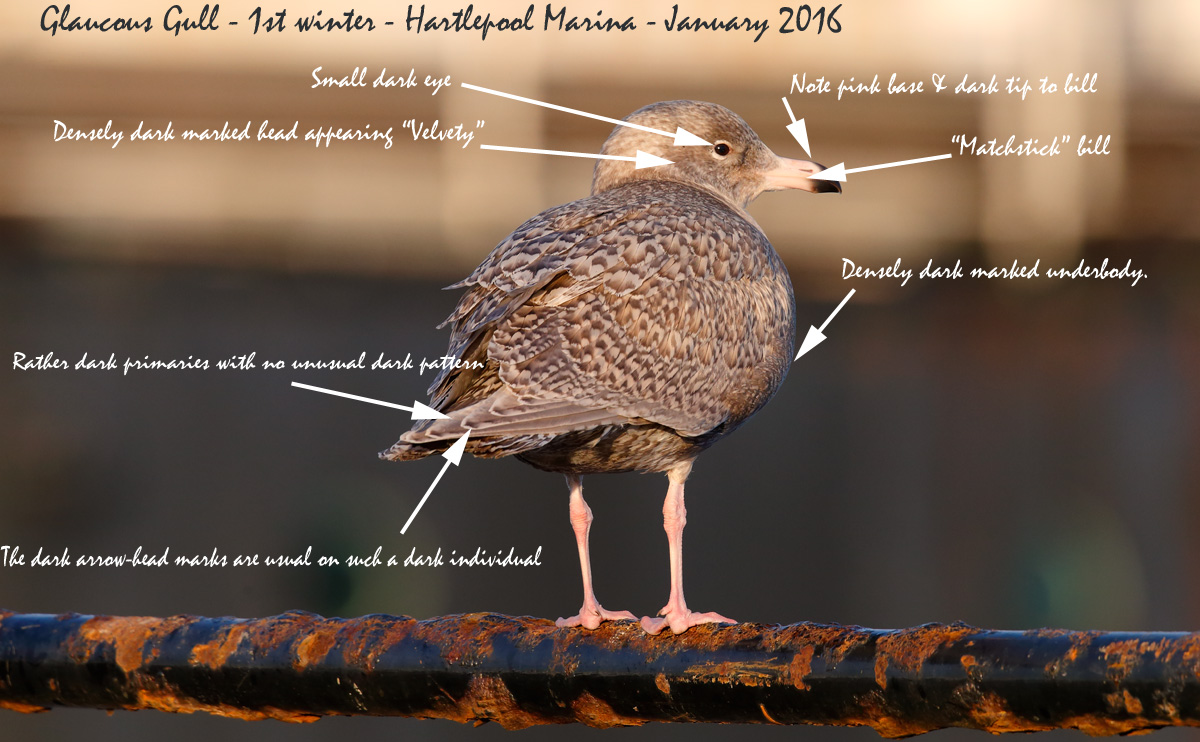Glyn, Richard and myself visited Hartlepool, Teeside on 16th January 2016, to photograph the Juvenile Glaucous Gull that had been frequenting the Marina at Jackson’s Landing. The bird had been showing very well and so it was a good opportunity to see one of these “High Arctic” Gulls at close quarters. One of the first features that struck me about the bird was how dark it was, especially in comparison to other Juvenile/1st winter Glaucous Gulls that were at various other sites throughout the UK at the time. Therefore allowing some comparison. I had never seen a young Glaucous Gull as dark as this bird before, but knew they existed.
So, whilst processing my photos, I had a few nagging doubts about the bird, could it be some sort of a hybrid? I checked various photos on the internet of other Hybrid Types and other first winters, also using the Gulls of Europe, Asia and North America guide as a source of reference. I spoke to Glyn, who thought it was most probably a very dark Glaucous Gull, but it was worth checking out and getting an opinion from an expert. So we both made a few independent enquiries to various people, including Klaus Malling Olsen, one of the authors of Gulls of Europe, Asia and North America. Klaus was, so far, the only person to quickly respond and he did so in a friendly and authoritative way, giving us his opinion on this interesting and beautiful 1st year Glaucous Gull.
Klaus described the bird as a very nice dark individual, showing no abnormal plumage features and with a perfect head shape, a small dark eye, with a typical “Matchstick” bill, pink base and dark tip.
Bills on hybrids often show darker markings in the bill, including the cutting edges, which is not the case in this bird. So the bill is spot on for 1st winter Glaucous, the head is also right with a smallish dark eye and densely dark-marked feathering with a velvety feel about it. Also the underbody shows same dark-marked plumage, typically appearing velvety. The primaries are rather dark, but again typically without any disturbing dark-pattern features, such as dark pattern in the outer-webs of outer primaries. The narrow dark “arrow-head” markings at the primary tips are a normal feature of such dark type individuals.
Hybrids would often show darker ground colour to normally more extensive barring in upper-parts, an indication of a dark tail band and often darker centred tertials and secondaries. None of these features are shown in this bird.
My thanks go to Glyn for making contact with Klaus and to Klaus for coming back with such a comprehensive overview of this bird.

Glaucous Gull – 1st winter – a rather dark individual, not the normal 1st winter type that we often encounter. – Tony Davison©

Glaucous Gull – 1st winter – Hartlepool Marina, Teeside – January 16th 2016 – Tony Davison©
